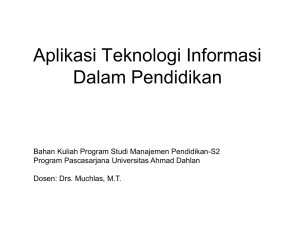Search for Production of Invisible Final States in Single- Please share
advertisement
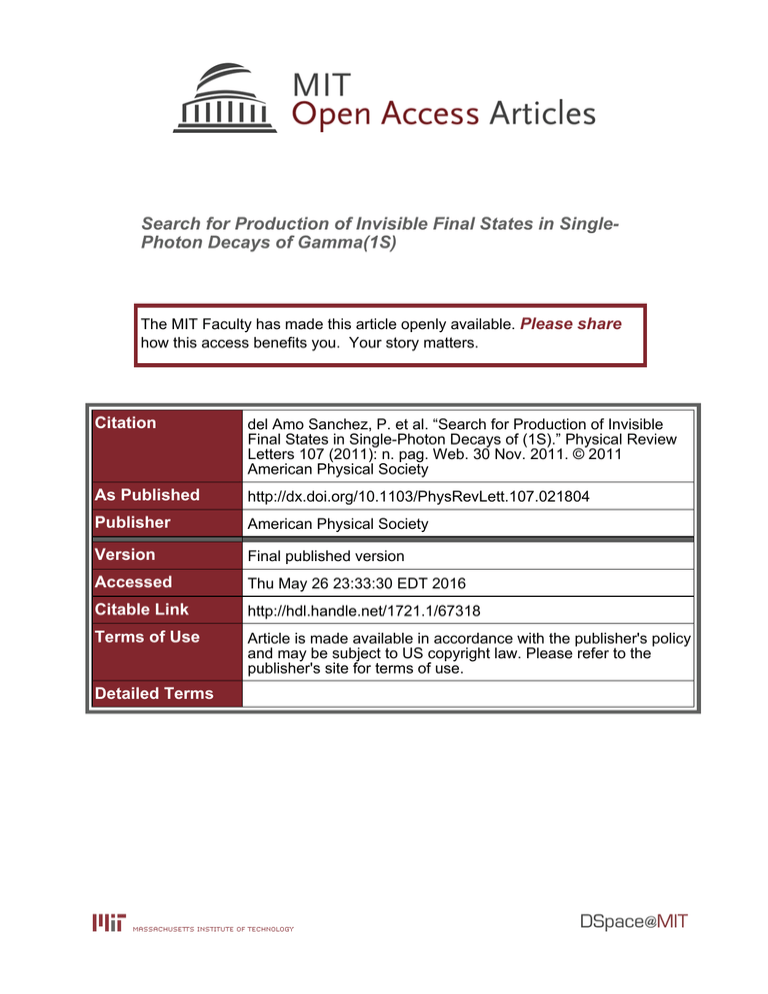
Search for Production of Invisible Final States in SinglePhoton Decays of Gamma(1S) The MIT Faculty has made this article openly available. Please share how this access benefits you. Your story matters. Citation del Amo Sanchez, P. et al. “Search for Production of Invisible Final States in Single-Photon Decays of (1S).” Physical Review Letters 107 (2011): n. pag. Web. 30 Nov. 2011. © 2011 American Physical Society As Published http://dx.doi.org/10.1103/PhysRevLett.107.021804 Publisher American Physical Society Version Final published version Accessed Thu May 26 23:33:30 EDT 2016 Citable Link http://hdl.handle.net/1721.1/67318 Terms of Use Article is made available in accordance with the publisher's policy and may be subject to US copyright law. Please refer to the publisher's site for terms of use. Detailed Terms PRL 107, 021804 (2011) PHYSICAL REVIEW LETTERS week ending 8 JULY 2011 Search for Production of Invisible Final States in Single-Photon Decays of ð1SÞ P. del Amo Sanchez,1 J. P. Lees,1 V. Poireau,1 E. Prencipe,1 V. Tisserand,1 J. Garra Tico,2 E. Grauges,2 M. Martinelli,3a,3b D. A. Milanes,3a,3b A. Palano,3a,3b M. Pappagallo,3a,3b G. Eigen,4 B. Stugu,4 L. Sun,4 D. N. Brown,5 M. V. Chistiakova,5 F. Jensen,5 L. T. Kerth,5 Yu. G. Kolomensky,5 G. Lynch,5 I. L. Osipenkov,5 H. Koch,6 T. Schroeder,6 D. J. Asgeirsson,7 C. Hearty,7 T. S. Mattison,7 J. A. McKenna,7 A. Khan,8 A. Randle-Conde,8 V. E. Blinov,9 A. R. Buzykaev,9 V. P. Druzhinin,9 V. B. Golubev,9 E. A. Kravchenko,9 A. P. Onuchin,9 S. I. Serednyakov,9 Yu. I. Skovpen,9 E. P. Solodov,9 K. Yu. Todyshev,9 A. N. Yushkov,9 M. Bondioli,10 S. Curry,10 D. Kirkby,10 A. J. Lankford,10 M. Mandelkern,10 E. C. Martin,10 D. P. Stoker,10 H. Atmacan,11 J. W. Gary,11 F. Liu,11 O. Long,11 G. M. Vitug,11 C. Campagnari,12 T. M. Hong,12 D. Kovalskyi,12 J. D. Richman,12 C. West,12 A. M. Eisner,13 C. A. Heusch,13 J. Kroseberg,13 W. S. Lockman,13 A. J. Martinez,13 T. Schalk,13 B. A. Schumm,13 A. Seiden,13 L. O. Winstrom,13 C. H. Cheng,14 D. A. Doll,14 B. Echenard,14 D. G. Hitlin,14 P. Ongmongkolkul,14 F. C. Porter,14 A. Y. Rakitin,14 R. Andreassen,15 M. S. Dubrovin,15 G. Mancinelli,15 B. T. Meadows,15 M. D. Sokoloff,15 P. C. Bloom,16 W. T. Ford,16 A. Gaz,16 M. Nagel,16 U. Nauenberg,16 J. G. Smith,16 S. R. Wagner,16 R. Ayad,17,* W. H. Toki,17 H. Jasper,18 T. M. Karbach,18 A. Petzold,18 B. Spaan,18 M. J. Kobel,19 K. R. Schubert,19 R. Schwierz,19 D. Bernard,20 M. Verderi,20 P. J. Clark,21 S. Playfer,21 J. E. Watson,21 M. Andreotti,22a,22b D. Bettoni,22a C. Bozzi,22a R. Calabrese,22a,22b A. Cecchi,22a,22b G. Cibinetto,22a,22b E. Fioravanti,22a,22b P. Franchini,22a,22b I. Garzia,22a,22b E. Luppi,22a,22b M. Munerato,22a,22b M. Negrini,22a,22b A. Petrella,22a,22b L. Piemontese,22a,22b R. Baldini-Ferroli,23 A. Calcaterra,23 R. de Sangro,23 G. Finocchiaro,23 M. Nicolaci,23 S. Pacetti,23 P. Patteri,23 I. M. Peruzzi,23,† M. Piccolo,23 M. Rama,23 A. Zallo,23 R. Contri,24a,24b E. Guido,24a,24b M. Lo Vetere,24a,24b M. R. Monge,24a,24b S. Passaggio,24a C. Patrignani,24a,24b E. Robutti,24a S. Tosi,24a,24b B. Bhuyan,25 V. Prasad,25 C. L. Lee,26 M. Morii,26 A. Adametz,27 J. Marks,27 U. Uwer,27 F. U. Bernlochner,28 M. Ebert,28 H. M. Lacker,28 T. Lueck,28 A. Volk,28 P. D. Dauncey,29 M. Tibbetts,29 P. K. Behera,30 U. Mallik,30 C. Chen,31 J. Cochran,31 H. B. Crawley,31 L. Dong,31 W. T. Meyer,31 S. Prell,31 E. I. Rosenberg,31 A. E. Rubin,31 A. V. Gritsan,32 Z. J. Guo,32 N. Arnaud,33 M. Davier,33 D. Derkach,33 J. Firmino da Costa,33 G. Grosdidier,33 F. Le Diberder,33 A. M. Lutz,33 B. Malaescu,33 A. Perez,33 P. Roudeau,33 M. H. Schune,33 J. Serrano,33 V. Sordini,33,‡ A. Stocchi,33 L. Wang,33 G. Wormser,33 D. J. Lange,34 D. M. Wright,34 I. Bingham,35 C. A. Chavez,35 J. P. Coleman,35 J. R. Fry,35 E. Gabathuler,35 R. Gamet,35 D. E. Hutchcroft,35 D. J. Payne,35 C. Touramanis,35 A. J. Bevan,36 F. Di Lodovico,33 R. Sacco,36 M. Sigamani,36 G. Cowan,37 S. Paramesvaran,37 A. C. Wren,37 D. N. Brown,38 C. L. Davis,38 A. G. Denig,39 M. Fritsch,39 W. Gradl,39 A. Hafner,39 K. E. Alwyn,40 D. Bailey,40 R. J. Barlow,40 G. Jackson,40 G. D. Lafferty,40 J. Anderson,41 R. Cenci,41 A. Jawahery,41 D. A. Roberts,41 G. Simi,41 J. M. Tuggle,41 C. Dallapiccola,42 E. Salvati,42 R. Cowan,43 D. Dujmic,43 G. Sciolla,43 M. Zhao,43 D. Lindemann,44 P. M. Patel,44 S. H. Robertson,44 M. Schram,44 P. Biassoni,45a,45b A. Lazzaro,45a,45b V. Lombardo,45a F. Palombo,45a,45b S. Stracka,45a,45b L. Cremaldi,46 R. Godang,46,x R. Kroeger,46 P. Sonnek,46 D. J. Summers,46 X. Nguyen,47 M. Simard,47 P. Taras,47 G. De Nardo,48a,48b D. Monorchio,48a,48b G. Onorato,48a,48b C. Sciacca,48a,48b G. Raven,49 H. L. Snoek,49 C. P. Jessop,50 K. J. Knoepfel,50 J. M. LoSecco,50 W. F. Wang,50 L. A. Corwin,51 K. Honscheid,51 R. Kass,51 J. P. Morris,51 N. L. Blount,52 J. Brau,52 R. Frey,52 O. Igonkina,52 J. A. Kolb,52 R. Rahmat,52 N. B. Sinev,52 D. Strom,52 J. Strube,52 E. Torrence,52 G. Castelli,53a,53b E. Feltresi,53a,53b N. Gagliardi,53a,53b M. Margoni,53a,53b M. Morandin,53a M. Posocco,53a M. Rotondo,53a F. Simonetto,53a,53b R. Stroili,53a,53b E. Ben-Haim,54 G. R. Bonneaud,54 H. Briand,54 G. Calderini,54 J. Chauveau,54 O. Hamon,54 Ph. Leruste,54 G. Marchiori,54 J. Ocariz,54 J. Prendki,54 S. Sitt,54 M. Biasini,55a,55b E. Manoni,55a,55b A. Rossi,55a,55b C. Angelini,56a,56b G. Batignani,56a,56b S. Bettarini,56a,56b M. Carpinelli,56a,56b,k G. Casarosa,56a,56b A. Cervelli,56a,56b F. Forti,56a,56b M. A. Giorgi,56a,56b A. Lusiani,56a,56c N. Neri,56a,56b E. Paoloni,56a,56b G. Rizzo,56a,56b J. J. Walsh,56a D. Lopes Pegna,57 C. Lu,57 J. Olsen,57 A. J. S. Smith,57 A. V. Telnov,57 F. Anulli,58a E. Baracchini,58a,58b G. Cavoto,58a R. Faccini,58a,58b F. Ferrarotto,58a F. Ferroni,58a,58b M. Gaspero,58a,58b L. Li Gioi,58a M. A. Mazzoni,58a G. Piredda,58a F. Renga,58a,58b T. Hartmann,59 T. Leddig,59 H. Schröder,59 R. Waldi,59 T. Adye,60 B. Franek,60 E. O. Olaiya,60 F. F. Wilson,60 S. Emery,61 G. Hamel de Monchenault,61 G. Vasseur,61 Ch. Yèche,61 M. Zito,61 M. T. Allen,62 D. Aston,62 D. J. Bard,62 R. Bartoldus,62 J. F. Benitez,62 C. Cartaro,62 M. R. Convery,62 J. Dorfan,62 G. P. Dubois-Felsmann,62 W. Dunwoodie,62 R. C. Field,62 M. Franco Sevilla,62 B. G. Fulsom,62 A. M. Gabareen,62 M. T. Graham,62 P. Grenier,62 C. Hast,62 W. R. Innes,62 M. H. Kelsey,62 H. Kim,62 P. Kim,62 M. L. Kocian,62 D. W. G. S. Leith,62 S. Li,62 B. Lindquist,62 S. Luitz,62 V. Luth,62 H. L. Lynch,62 D. B. MacFarlane,62 H. Marsiske,62 D. R. Muller,62 H. Neal,62 S. Nelson,62 C. P. O’Grady,62 I. Ofte,62 M. Perl,62 T. Pulliam,62 B. N. Ratcliff,62 A. Roodman,62 A. A. Salnikov,62 V. Santoro,62 R. H. Schindler,62 J. Schwiening,62 0031-9007=11=107(2)=021804(7) 021804-1 Ó 2011 American Physical Society PRL 107, 021804 (2011) PHYSICAL REVIEW LETTERS week ending 8 JULY 2011 A. Snyder,62 D. Su,62 M. K. Sullivan,62 S. Sun,62 K. Suzuki,62 J. M. Thompson,62 J. Va’vra,62 A. P. Wagner,62 M. Weaver,62 W. J. Wisniewski,62 M. Wittgen,62 D. H. Wright,62 H. W. Wulsin,62 A. K. Yarritu,62 C. C. Young,62 V. Ziegler,62 X. R. Chen,63 W. Park,63 M. V. Purohit,63 R. M. White,63 J. R. Wilson,63 S. J. Sekula,64 M. Bellis,65 P. R. Burchat,65 A. J. Edwards,65 T. S. Miyashita,65 S. Ahmed,66 M. S. Alam,66 J. A. Ernst,66 B. Pan,66 M. A. Saeed,66 S. B. Zain,66 N. Guttman,67 A. Soffer,67 P. Lund,68 S. M. Spanier,68 R. Eckmann,69 J. L. Ritchie,69 A. M. Ruland,69 C. J. Schilling,69 R. F. Schwitters,69 B. C. Wray,69 J. M. Izen,70 X. C. Lou,70 F. Bianchi,71a,71b D. Gamba,71a,71b M. Pelliccioni,71a,71b M. Bomben,72a,72b L. Lanceri,72a,72b L. Vitale,72a,72b N. Lopez-March,73 F. Martinez-Vidal,73 A. Oyanguren,73 J. Albert,74 Sw. Banerjee,74 H. H. F. Choi,74 K. Hamano,74 G. J. King,74 R. Kowalewski,74 M. J. Lewczuk,74 C. Lindsay,74 I. M. Nugent,74 J. M. Roney,74 R. J. Sobie,74 T. J. Gershon,75 P. F. Harrison,75 T. E. Latham,75 E. M. T. Puccio,75 H. R. Band,76 S. Dasu,76 K. T. Flood,76 Y. Pan,76 R. Prepost,76 C. O. Vuosalo,76 and S. L. Wu76 (BABAR Collaboration) 1 Laboratoire d’Annecy-le-Vieux de Physique des Particules (LAPP), Université de Savoie, CNRS/IN2P3, F-74941 Annecy-Le-Vieux, France 2 Universitat de Barcelona, Facultat de Fisica, Departament ECM, E-08028 Barcelona, Spain 3a INFN Sezione di Bari, I-70126 Bari, Italy 3b Dipartimento di Fisica, Università di Bari, I-70126 Bari, Italy 4 University of Bergen, Institute of Physics, N-5007 Bergen, Norway 5 Lawrence Berkeley National Laboratory and University of California, Berkeley, California 94720, USA 6 Ruhr Universität Bochum, Institut für Experimentalphysik 1, D-44780 Bochum, Germany 7 University of British Columbia, Vancouver, British Columbia, Canada V6T 1Z1 8 Brunel University, Uxbridge, Middlesex UB8 3PH, United Kingdom 9 Budker Institute of Nuclear Physics, Novosibirsk 630090, Russia 10 University of California at Irvine, Irvine, California 92697, USA 11 University of California at Riverside, Riverside, California 92521, USA 12 University of California at Santa Barbara, Santa Barbara, California 93106, USA 13 University of California at Santa Cruz, Institute for Particle Physics, Santa Cruz, California 95064, USA 14 California Institute of Technology, Pasadena, California 91125, USA 15 University of Cincinnati, Cincinnati, Ohio 45221, USA 16 University of Colorado, Boulder, Colorado 80309, USA 17 Colorado State University, Fort Collins, Colorado 80523, USA 18 Technische Universität Dortmund, Fakultät Physik, D-44221 Dortmund, Germany 19 Technische Universität Dresden, Institut für Kern-und Teilchenphysik, D-01062 Dresden, Germany 20 Laboratoire Leprince-Ringuet, CNRS/IN2P3, Ecole Polytechnique, F-91128 Palaiseau, France 21 University of Edinburgh, Edinburgh EH9 3JZ, United Kingdom 22a INFN Sezione di Ferrara, I-44100 Ferrara, Italy 22b Dipartimento di Fisica, Università di Ferrara, I-44100 Ferrara, Italy 23 INFN Laboratori Nazionali di Frascati, I-00044 Frascati, Italy 24a INFN Sezione di Genova, I-16146 Genova, Italy 24b Dipartimento di Fisica, Università di Genova, I-16146 Genova, Italy 25 Indian Institute of Technology Guwahati, Guwahati, Assam, 781 039, India 26 Harvard University, Cambridge, Massachusetts 02138, USA 27 Universität Heidelberg, Physikalisches Institut, Philosophenweg 12, D-69120 Heidelberg, Germany 28 Humboldt-Universität zu Berlin, Institut für Physik, Newtonstraße 15, D-12489 Berlin, Germany 29 Imperial College London, London, SW7 2AZ, United Kingdom 30 University of Iowa, Iowa City, Iowa 52242, USA 31 Iowa State University, Ames, Iowa 50011-3160, USA 32 Johns Hopkins University, Baltimore, Maryland 21218, USA 33 Laboratoire de l’Accélérateur Linéaire, IN2P3/CNRS et Université Paris-Sud 11, Centre Scientifique d’Orsay, Boı̂te Postale 34, F-91898 Orsay Cedex, France 34 Lawrence Livermore National Laboratory, Livermore, California 94550, USA 35 University of Liverpool, Liverpool L69 7ZE, United Kingdom 36 Queen Mary, University of London, London, E1 4NS, United Kingdom 37 University of London, Royal Holloway and Bedford New College, Egham, Surrey TW20 0EX, United Kingdom 38 University of Louisville, Louisville, Kentucky 40292, USA 39 Johannes Gutenberg-Universität Mainz, Institut für Kernphysik, D-55099 Mainz, Germany 40 University of Manchester, Manchester M13 9PL, United Kingdom 021804-2 PHYSICAL REVIEW LETTERS PRL 107, 021804 (2011) week ending 8 JULY 2011 41 University of Maryland, College Park, Maryland 20742, USA University of Massachusetts, Amherst, Massachusetts 01003, USA 43 Massachusetts Institute of Technology, Laboratory for Nuclear Science, Cambridge, Massachusetts 02139, USA 44 McGill University, Montréal, Québec, Canada H3A 2T8 45a INFN Sezione di Milano, I-20133 Milano, Italy 45b Dipartimento di Fisica, Università di Milano, I-20133 Milano, Italy 46 University of Mississippi, University, Mississippi 38677, USA 47 Université de Montréal, Physique des Particules, Montréal, Québec, Canada H3C 3J7 48a INFN Sezione di Napoli, I-80126 Napoli, Italy 48b Dipartimento di Scienze Fisiche, Università di Napoli Federico II, I-80126 Napoli, Italy 49 NIKHEF, National Institute for Nuclear Physics and High Energy Physics, NL-1009 DB Amsterdam, The Netherlands 50 University of Notre Dame, Notre Dame, Indiana 46556, USA 51 Ohio State University, Columbus, Ohio 43210, USA 52 University of Oregon, Eugene, Oregon 97403, USA 53a INFN Sezione di Padova, I-35131 Padova, Italy 53b Dipartimento di Fisica, Università di Padova, I-80126 Napoli, Italy 54 Laboratoire de Physique Nucléaire et de Hautes Energies, IN2P3/CNRS, Université Pierre et Marie Curie-Paris6, Université Denis Diderot-Paris7, F-75252 Paris, France 55a INFN Sezione di Perugia, I-06100 Perugia, Italy 55b Dipartimento di Fisica, Università di Perugia, I-06100 Perugia, Italy 56a INFN Sezione di Pisa, I-56127 Pisa, Italy 56b Dipartimento di Fisica, Università di Pisa, I-56127 Pisa, Italy 56c Scuola Normale Superiore di Pisa, I-56127 Pisa, Italy 57 Princeton University, Princeton, New Jersey 08544, USA 58a INFN Sezione di Roma, I-00185 Roma, Italy 58b Dipartimento di Fisica, Università di Roma La Sapienza, I-00185 Roma, Italy 59 Universität Rostock, D-18051 Rostock, Germany 60 Rutherford Appleton Laboratory, Chilton, Didcot, Oxon, OX11 0QX, United Kingdom 61 CEA, Irfu, SPP, Centre de Saclay, F-91191 Gif-sur-Yvette, France 62 SLAC National Accelerator Laboratory, Stanford, California 94309 USA 63 University of South Carolina, Columbia, South Carolina 29208, USA 64 Southern Methodist University, Dallas, Texas 75275, USA 65 Stanford University, Stanford, California 94305-4060, USA 66 State University of New York, Albany, New York 12222, USA 67 Tel Aviv University, School of Physics and Astronomy, Tel Aviv, 69978, Israel 68 University of Tennessee, Knoxville, Tennessee 37996, USA 69 University of Texas at Austin, Austin, Texas 78712, USA 70 University of Texas at Dallas, Richardson, Texas 75083, USA 71a INFN Sezione di Torino, I-10125 Torino, Italy 71b Dipartimento di Fisica Sperimentale, Università di Torino, I-10125 Torino, Italy 72a INFN Sezione di Trieste, I-34127 Trieste, Italy 72b Dipartimento di Fisica, Università di Trieste, I-34127 Trieste, Italy 73 IFIC, Universitat de Valencia-CSIC, E-46071 Valencia, Spain 74 University of Victoria, Victoria, British Columbia, Canada V8W 3P6 75 Department of Physics, University of Warwick, Coventry CV4 7AL, United Kingdom 76 University of Wisconsin, Madison, Wisconsin 53706, USA (Received 26 July 2010; published 6 July 2011) 42 We search for single-photon decays of the ð1SÞ resonance, ! þ invisible, where the invisible state is either a particle of definite mass, such as a light Higgs boson A0 , or a pair of dark matter particles, Both A0 and are assumed to have zero spin. We tag ð1SÞ decays with a dipion transition ð2SÞ ! . þ ð1SÞ and look for events with a single energetic photon and significant missing energy. We find no evidence for such processes in the mass range mA0 9:2 GeV and m 4:5 GeV in the sample of 98 106 ð2SÞ decays collected with the BABAR detector and set stringent limits on new physics models that contain light dark matter states. DOI: 10.1103/PhysRevLett.107.021804 PACS numbers: 13.20.Gd, 12.60.Jv, 14.80.Da, 95.35.+d There is compelling astrophysical evidence for the existence of dark matter [1,2], which amounts to about one-quarter of the total energy density in the Universe. Yet there is no experimental information on the particle 021804-3 PRL 107, 021804 (2011) PHYSICAL REVIEW LETTERS composition of dark matter [2,3]. A class of new physics models [4], motivated by astroparticle observations [5,6], predicts a light component of the dark matter spectrum. The bottomonium system of states is an ideal environment to explore these models. Transitions ð3SÞ ! þ ð1SÞ and ð2SÞ ! þ ð1SÞ offer a way to cleanly detect the production of ð1SÞ mesons, and enable searches for invisible or nearly invisible decays of the ð1SÞ [7]. Such decays would be a telltale sign of lowmass, weakly interacting dark matter particles. The standard model process ð1SÞ ! is not observable at the present experimental sensitivity [8]. An observation of decays with significant missing energy would be a sign of new physics, and could shed light on the spectrum of dark matter particles . The branching fraction is estimated to be as large as (BF) Bðð1SÞ ! Þ is supð4–18Þ 104 [8,9], while Bðð1SÞ ! Þ pressed by OðÞ, and the range 105 –104 is expected [8]. The decays ð1SÞ ! þ invisible might also proceed through Wilczek production [10] of an on-shell scalar state A0 : ð1SÞ ! A0 , A0 ! invisible. Such low-mass Higgs states appear in several extensions of the standard model [11]. Constraining the low-mass Higgs sector is important for understanding the Higgs discovery reach of highenergy colliders [12]. The BF for ð1SÞ ! A0 is predicted to be as large as 5 104 , depending on mA0 and couplings [13]. If there is also a low-mass neutralino with mass m < mA0 =2, the decays of A0 would be predominantly invisible [14]. For multibody ð1SÞ ! decays, the current 90% confidence level (C.L.) BF upper limit, based on a data sample of 106 ð1SÞ decays, is of order 103 [15]. The limit on two-body ð1SÞ ! þ X, X ! invisible decays is Bðð1SÞ ! þ XÞ < 3 105 for mX < 7:2 GeV [3]. The limit on invisible decays of ð1SÞ is Bðð1SÞ ! < 3:0 104 [7]. Þ This Letter describes a high-statistics, low-background search for decays ð1SÞ ! þ invisible, characterized by a single energetic photon and a large amount of missing energy and momentum. This is the first search of this kind to use the ð1SÞ mesons produced in dipion ð2SÞ ! þ ð1SÞ transitions. We search for both resonant two-body decays ð1SÞ ! A0 , A0 ! invisible, and non For the resonant three-body processes ð1SÞ ! . resonant process, we assume that the decay width of the A0 resonance is negligible compared to the experimental resolution [16]. We further assume that both the A0 and particles have zero spin. The decays ð1SÞ ! are modeled with phase-space energy and angular distributions, which corresponds to S-wave coupling between the bb and . The analysis is based on a sample corresponding to an integrated luminosity of 14:4 fb1 collected on the ð2SÞ resonance with the BABAR detector at the PEP-II asymmetric-energy eþ e collider at the SLAC National week ending 8 JULY 2011 Accelerator Laboratory. This sample corresponds to ð98:3 0:9Þ 106 ð2SÞ decays. We also employ a sample of 28 fb1 accumulated on the ð3SÞ resonance [ð3SÞ sample] for studies of the continuum backgrounds. Both ð3SÞ ! þ ð2SÞ and ð3SÞ ! þ ð1SÞ decays produce a dipion system that is kinematically distinct from the ð2SÞ ! þ ð1SÞ transition. Hence, the ð3SÞ events passing our selection form a pure high-statistics continuum QED sample. For selection optimization, we also use 1:4 fb1 and 2:4 fb1 data sets collected about 30 MeV below the ð2SÞ and ð3SÞ resonances, respectively (off-peak samples). The BABAR detector, including the tracking and particle identification systems, the electromagnetic calorimeter (EMC), and the instrumented flux return (IFR), is described in detail elsewhere [17,18]. Detection of low-multiplicity events requires dedicated trigger and filter lines. First, the hardware-based level-1 (L1) trigger accepts single-photon events if they contain at least one EMC cluster with energy above 800 MeV. A collection of L1 trigger patterns based on drift chamber information selects a pair of low-momentum pions. Second, a software-based level-3 (L3) trigger accepts events with a single EMC cluster with the center-of-mass (c.m.) energy E > 1 GeV [19], if there is no charged track with transverse momentum pT > 0:25 GeV originating from the eþ e interaction region. Complementary to this, a track-based L3 trigger accepts events that have at least one track with pT > 0:2 GeV. Third, an offline filter accepts events that have exactly one photon with energy E > 1 GeV, and no tracks with momentum p > 0:5 GeV. A nearly independent filter accepts events with two tracks of opposite charge, which form a dipion candidate with recoil mass (defined below) between 9.35 and 9.60 GeV. The analysis in the low-mass region mA0 8 GeV (m 4 GeV), which corresponds to photon energies E > 1:1 GeV, requires the single-photon or the dipion trigger or filter selection to be satisfied; the trigger or filter efficiency for the signal is 83%. In the high-mass region, 7:5 mA0 9:2 GeV (3:5 m 4:5 GeV), we only accept events selected with the dipion trigger or filter, since a significant fraction of this region lies below the energy threshold for the single-photon selection. This selection has an efficiency of 12.5% for signal events. We select events with exactly two oppositely charged tracks and a single energetic photon with E 0:15 GeV in the central part of the EMC ( 0:73 < cos < 0:68). Additional photons with E 0:12 GeV can be present so long as their summed laboratory energy is less than 0.14 GeV. We require that both pions be positively identified with 85%–98% efficiency for real pions, and a misidentification rate of <5% for low-momentum electrons and <1% for kaons and protons. The pion candidates are required to form a vertex with 2vtx < 20 (1 degree of freedom) displaced in the transverse plane by at most 021804-4 PRL 107, 021804 (2011) PHYSICAL REVIEW LETTERS 2 mm from the eþ e interaction region. The transverse momentum of the pion pair is required to satisfy pT < 0:5 GeV, and we reject events if any track has p > 1 GeV. We further reduce the background by combining several kinematic variables of the dipion system [7] into a multilayer perceptron neural network discriminant (NN) [20]. The NN is trained with a sample of simulated signal events ð1SÞ ! (m ¼ 0) and an off-peak sample for background; the NN assigns a value N close to þ1 for signal and close to 1 for background. We require N > 0:65 in the low-mass region. This selection has an efficiency of 87% for signal and rejects 96% of the continuum background. In the high-mass region we require N > 0:89 (73% signal efficiency, 98% continuum rejection). Two additional requirements are applied to reduce specific background contributions. Neutral hadrons from the radiative decays ð1SÞ ! KL0 KL0 and ð1SÞ ! nn may not be detected in the EMC. We remove 90% of these background events by requiring that there be no IFR cluster within a range of 20 of azimuthal angle () opposite the primary photon (IFR veto). This selection is applied for mA0 < 4 GeV and m < 2 GeV, since the hadronic final states in radiative ð1SÞ decays are observed to have low invariant mass [21]. For the high-mass range we suppress contamination from electron bremsstrahlung by rejecting events if the photon and one of the tracks are closer than 14 in . In addition, the two-photon process eþ e ! eþ e ! eþ e 0 , 0 ! þ , in which the eþ e pair escapes detection along the beam axis and the two pions satisfy our selection criteria, produces photons in a narrow energy range 0:25 < E < 0:45 GeV. We take advantage of the small transverse momentum of the 0 and reject over half of these events by requiring the primary photon and dipion system to be separated by at most ¼ 160 . The signal efficiency for this requirement is 88%. pffiffiffiThe ffi selection criteria are chosen to maximize "=ð1:5 þ BÞ [22], where " is the selection efficiency for m ¼ 0 and B is the expected background yield. The signal efficiency varies between 2% and 11%, and is lowest at the highest masses (lowest photon energy). The backgrounds can be classified into three categories: continuum backgrounds from QED processes eþ e ! þ þ . . . with particles escaping detection, radiative leptonic decays ð1SÞ ! ‘þ ‘ , where leptons ‘ e, , are not detected, and peaking backgrounds from radiative hadronic decays and two-photon 0 production. We extract the yield of signal events as a function of mA0 (m ) in the interval 0 mA0 9:2 GeV (0 m 4:5 GeV) by performing a series of unbinned extended maximum likelihood scans in steps of mA0 (m ). We use two kinematic variables: the dipion recoil mass Mrecoil and the missing mass squared MX2 , week ending 8 JULY 2011 2 2 Mrecoil ¼ Mð2SÞ þ m2 2Mð2SÞ E ; (1) MX2 ¼ ðP eþ e P P Þ2 ; (2) where E is the c.m. energy of the dipion system, and P is the four-momentum. The two-dimensional likelihood function is computed for observables ðMrecoil ; MX2 Þ over the range 9:44 Mrecoil 9:48 GeV and 10 MX2 68 GeV2 (low-mass region) and 40 MX2 84:5 GeV2 (high-mass region). It contains contributions from signal, continuum background, radiative leptonic ð1SÞ background, and peaking backgrounds, as described below. We search for the A0 in mass steps equivalent to half the mass resolution ðmA0 Þ. We sample a total of 196 points in the low-mass 0 mA0 8 GeV range, and 146 points in the high-mass range 7:5 mA0 9:2 GeV. For the ð1SÞ ! search, we use 17 values of m over 0 m 4:5 GeV. For each mA0 (m ) value, we compute the value of the negative log-likelihood NLL ¼ lnLðNsig Þ in steps of the signal yield Nsig 0 while minimizing NLL with respect to the background yields Ncont (continuum), Nlept [ð1SÞ ! ‘þ ‘ ], and, where appropriate, Nhadr (radiative hadronic background) or N0 (two-photon 0 background). If the minimum of NLL occurs for Nsig > 0, we compute the raw statistical sigpffiffiffiffiffiffiffiffiffiffiffiffiffiffiffiffiffiffiffiffiffiffiffiffiffiffiffi nificance of a particular fit as S ¼ 2 logðL=L0 Þ, where L0 is the value of the likelihood for Nsig ¼ 0. For small S, we integrate LðNsig Þ with uniform prior over Nsig 0 to compute the 90% C.L. Bayesian upper limits. In the range 7:5 mA0 8 GeV and 3:5 m 4 GeV where the low-mass and high-mass selections overlap, we add NLLs from both data sets, ignoring a small (3%) correlation. This likelihood scan procedure is designed to handle samples with a very small number of events in the signal region. We use signal Monte Carlo samples [23,24] ð1SÞ ! A0 and ð1SÞ ! generated at 17 values of mA0 over a broad range 0 mA0 9:2 GeV and at 17 values of m over 0 m 4:5 GeV to determine the signal distributions in MX2 and selection efficiencies. We then interpolate these distributions and efficiencies. The signal probability density function (PDF) in MX2 is described by a crystal ball (CB) function [25] [ð1SÞ ! A0 ] or a resolution The resosmeared phase-space function [ð1SÞ ! ]. lution in MX2 is dominated by the photon energy resolution, and varies monotonically from 1 GeV2 at low mA0 to 0:2 GeV2 at mA0 ¼ 9:2 GeV. We correct the signal PDF in MX2 for the difference between the photon energy resolution function in data and simulation using a highstatistics eþ e ! sample. We determine the signal distribution in Mrecoil , as well as that of background containing real ð1SÞ decays, from a large data sample of events ð1SÞ ! þ . This PDF is modeled as a sum of two CB functions with a common mean, a common 021804-5 week ending 8 JULY 2011 (a) 10 8 6 4 2 0 15 (b) 6 4 2 (d) 10 8 10 6 4 5 0 9.44 30 25 20 15 10 5 0 9.44 8 0 (c) 2 9.45 9.46 9.47 9.48 0 0 20 40 60 2 (e) 10 (f) 10 1 -1 9.45 9.46 9.47 9.48 10 40 Mrecoil (GeV) 50 60 70 80 MX2 (GeV2) FIG. 1 (color online). Projection plots from the fit with Nsig ¼ 0 onto (a,c,e) Mrecoil and (b,d,f) MX2 . (a,b) Low-mass region with IFR veto, (c,d) low-mass region without IFR veto, (e,f) highmass region. Overlaid is the fit with Nsig ¼ 0 (solid blue line), continuum background (black dashed line), radiative leptonic ð1SÞ decays (green dash-dotted line), and (c,d) radiative hadronic ð1SÞ decays or (e,f) 0 background (magenta dotted line). possible biases in the fitted value of the signal yield with a large ensemble of pseudoexperiments. The biases are consistent with zero for all values of mA0 and m , and we assign an uncertainty of 0.25 events. As a first step in the likelihood scan, we perform fits to the low-mass and high-mass regions with Nsig ¼ 0. The free parameters in the fit are Ncont , Nlept , and Nhadr (lowmass region), and Ncont , Nlept , and N0 (high-mass region). The results of the fits are shown in Fig. 1. We observe no significant deviations from the background-only BF UL @ 90% C.L. (10 -6) resolution ðMrecoil Þ 2 MeV, and two opposite-side tails. We describe the MX2 PDF of the radiative ð1SÞ ! ‘þ ‘ background by an exponential function, and determine the exponent from a fit to the distribution of MX2 in a ð1SÞ ! ‘þ ‘ data sample in which the two stable leptons (e or ) are fully reconstructed. Before the fit, this sample is reweighted by the probability as a function of MX2 that neither lepton is observed. The continuum MX2 PDF is described by a function that has a resolution-smeared phase-space component at low MX2 , and an exponential rise at high MX2 . For the low-mass selection ( 10 MX2 68 GeV2 ), we determine this PDF from a fit to the ð3SÞ data sample. For the highmass region (40 MX2 84:5 GeV2 ), we determine this PDF, as well as the MX2 PDF of the peaking 0 background, from a fit to the ð2SÞ data sample selected with the NN requirement N < 0. The Mrecoil PDF is determined from a fit to the ð3SÞ data sample. The contribution from the radiative hadronic backgrounds is estimated from the measurement of ð1SÞ ! hþ h spectra [21]. We assume isospin symmetry to relate Bðð1SÞ ! K þ K Þ to Bðð1SÞ ! KL0 KL0 Þ, and to Bðð1SÞ ! nnÞ. A small addiBðð1SÞ ! ppÞ tional contribution arises from ð1SÞ ! þ events in which the pions escape detection. We expect Nhadr ¼ 6:6 1:1 radiative hadronic events (without IFR veto), veto ¼ 1:02 0:14 dominated by ð1SÞ ! KL0 KL0 , or Nhadr events (with IFR veto). We describe the MX2 distribution of these events with a combination of CB functions, using the measured spectrum of ð1SÞ ! hþ h events [21]. The largest systematic uncertainty is on the reconstruction efficiency, which includes the trigger or filter efficiency ("trig ), and photon (" ) and dipion (" ) reconstruction and selection efficiencies. We measure the product " Nð1SÞ , where Nð1SÞ is the number of produced ð1SÞ mesons, with a clean high-statistics sample of the ð1SÞ ! þ decays. The uncertainty (2.1%) is dominated by Bðð1SÞ ! þ Þ (2%) [3] and a small selection uncertainty for the þ final state. We measure " in an eþ e ! sample in which one of the photons converts into an eþ e pair in the detector material (1.8% uncertainty). The trigger efficiency "trig is measured in unbiased random samples of events that bypass the trigger or filter selection. This uncertainty is small for the singlephoton triggers (0.4%), but is statistically limited for the dipion triggers (8%). In the low-mass region, we take into account the anticorrelation between single-photon and dipion trigger efficiencies in L3; the uncertainty for the combination of the triggers is 1.2%. We account for additional uncertainties associated with the signal and background PDFs, and the predicted number of radiative hadronic events Nhadr , including PDF parameter correlations. These uncertainties do not scale with the signal yield, but are found to be small. We also test for Events / ( 1 GeV 2 ) PHYSICAL REVIEW LETTERS Events / ( 0.001 GeV ) PRL 107, 021804 (2011) 10 1 0 2 4 6 mA0 (GeV) 8 FIG. 2 (color online). Ninety percent C.L. upper limits for Bðð1SÞ ! A0 Þ BðA0 ! invisibleÞ. 021804-6 PHYSICAL REVIEW LETTERS BF UL @ 90% C.L. (10 -6) PRL 107, 021804 (2011) 2 10 10 0 0.5 1 1.5 2 2.5 3 3.5 4 4.5 mχ (GeV) FIG. 3 (color online). Ninety percent C.L. upper limits for Bðð1SÞ ! Þ. hypothesis. We find Nhadr ¼ 8:7þ4:0 3:3 0:8 (without IFR veto) with a significance of 3:5, including systematic uncertainties. We then proceed to perform the likelihood scans as a function of Nsig in steps of mA0 and m . In the scan, the contribution of the radiative hadronic background is fixed to the expectation Nhadr ¼ 1:02 0:14 for mA0 < 4 GeV (m < 2 GeV) where the IFR veto is applied, and to Nhadr ¼ 6:6 1:1 for fits in the 4 mA0 8 GeV (2 m < 4 GeV) range. We do not observe a significant excess of events above the background, and set upper limits on Bðð1SÞ ! A0 Þ BðA0 ! invisibleÞ (Fig. 2) and (Fig. 3). The limits are dominated by Bðð1SÞ ! Þ statistical uncertainties. The largest statistical fluctuation, 2:0, is observed at mA0 ¼ 7:58 GeV [26]; we estimate the probability to see such a fluctuation anywhere in our data set to be over 30%. In summary, we find no evidence for the single-photon decays ð1SÞ ! þ invisible, and set 90% C.L. upper limits on Bðð1SÞ ! A0 Þ BðA0 ! invisibleÞ in the range ð1:9–4:5Þ 106 for 0 mA0 8:0 GeV, ð2:7–37Þ 106 for 8 mA0 9:2 GeV, and scalar A0 . in the range ð0:5–24Þ 105 We limit Bðð1SÞ ! Þ at 90% C.L. for 0 m 4:5 GeV, assuming the phasespace distribution of photons in this final state. Our results improve the existing limits by an order of magnitude or more, and significantly constrain [26] light Higgs boson [13] and light dark matter [8] models. We are grateful for the excellent luminosity and machine conditions provided by our PEP-II colleagues, and for the substantial dedicated effort from the computing organizations that support BABAR. The collaborating institutions wish to thank SLAC for its support and kind hospitality. This work is supported by DOE and NSF (USA), NSERC (Canada), CEA and CNRS-IN2P3 (France), BMBF and DFG (Germany), INFN (Italy), FOM (The Netherlands), NFR (Norway), MES (Russia), MICIIN (Spain), STFC (United Kingdom). Individuals have received support from the Marie Curie EIF (European Union), the A. P. Sloan Foundation (USA), and the Binational Science Foundation (USA-Israel). week ending 8 JULY 2011 *Now at Temple University, Philadelphia, PA 19122, USA. † Also with Dipartimento di Fisica, Università di Perugia, Perugia, Italy. ‡ Also with Università di Roma La Sapienza, I-00185 Roma, Italy. x Now at University of South Alabama, Mobile, AL 36688, USA. k Also with Università di Sassari, Sassari, Italy. [1] E. Komatsu et al. (WMAP Collaboration), Astrophys. J. Suppl. Ser. 180, 330 (2009); M. Tegmark et al. (SDSS Collaboration), Phys. Rev. D 74, 123507 (2006). [2] G. Bertone, D. Hooper, and J. Silk, Phys. Rep. 405, 279 (2005). [3] K. Nakamura et al. (Particle Data Group), J. Phys. G 37, 075021 (2010). [4] J. F. Gunion, D. Hooper, and B. McElrath, Phys. Rev. D 73, 015011 (2006). [5] P. Jean et al., Astron. Astrophys. 407, L55 (2003); J. Knodlseder et al., Astron. Astrophys. 411, L457 (2003). [6] R. Bernabei et al. (DAMA Collaboration), Eur. Phys. J. C 56, 333 (2008). [7] B. Aubert et al. (BABAR Collaboration), Phys. Rev. Lett. 103, 251801 (2009). [8] G. K. Yeghiyan, Phys. Rev. D 80, 115019 (2009). [9] R. McElrath, in Proceedings of the CHARM 2007 Workshop, Ithaca, NY, 2007, econf C070805, 19 (2007) (arXiv:0712.0016); P. Fayet, Phys. Rev. D 81, 054025 (2010). [10] F. Wilczek, Phys. Rev. Lett. 39, 1304 (1977). [11] R. Dermisek and J. F. Gunion, Phys. Rev. Lett. 95, 041801 (2005). [12] M. Lisanti and J. G. Wacker, Phys. Rev. D 79, 115006 (2009). [13] R. Dermisek, J. F. Gunion, and B. McElrath, Phys. Rev. D 76, 051105 (2007); R. Dermisek and J. F. Gunion, Phys. Rev. D 81, 075003 (2010). [14] R. E. Shrock and M. Suzuki, Phys. Lett. 110B, 250 (1982). [15] R. Balest et al. (CLEO Collaboration), Phys. Rev. D 51, 2053 (1995). [16] E. Fullana and M. A. Sanchis-Lozano, Phys. Lett. B 653, 67 (2007). [17] B. Aubert et al. (BABAR Collaboration), Nucl. Instrum. Methods Phys. Res., Sect. A 479, 1 (2002). [18] W. Menges, IEEE Nucl. Sci. Symp. Conf. Rec. 5, 1470 (2006). [19] Henceforth, marks c.m. quantities. [20] A. Höcker et al., Proc. Sci., ACAT (2007) 040; http://tmva.sourceforge.net/. [21] S. B. Athar et al. (CLEO Collaboration), Phys. Rev. D 73, 032001 (2006). [22] G. Punzi, arXiv:physics/0308063. [23] S. Agostinelli et al. (GEANT4 Collaboration), Nucl. Instrum. Methods Phys. Res., Sect. A 506, 250 (2003). [24] D. Lange, Nucl. Instrum. Methods Phys. Res., Sect. A 462, 152 (2001). [25] M. J. Oreglia, Ph.D. thesis [Report No. SLAC-236, 1980], Appendix D. [26] See supplemental material at http://link.aps.org/ supplemental/10.1103/PhysRevLett.107.021804 for additional plots. 021804-7
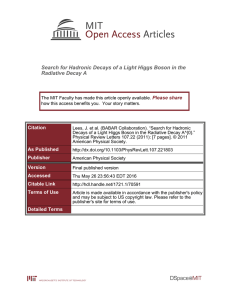
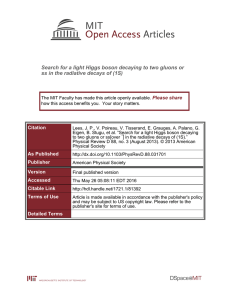
![Evidence for CP Violation in B[superscript +] p[bar over](http://s2.studylib.net/store/data/011769573_1-dbf6e69acc9987d47e98091a3410287d-300x300.png)
![Study of B[superscript ±]J/[superscript ±] and B[superscript ±]J/K[superscript ±] Decays: Measurement](http://s2.studylib.net/store/data/012104787_1-20327d67f8be61f1b239129cd07832b5-300x300.png)
![Observation of the baryonic decay [bar over ]K[superscript +]](http://s2.studylib.net/store/data/012124450_1-001f56a67a858aeb730c0dae2eb8ce7c-300x300.png)
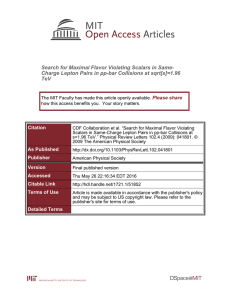
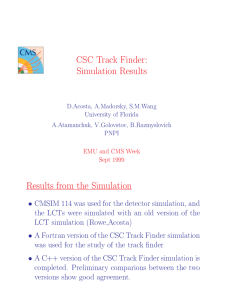
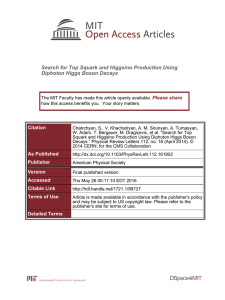
![Measurement of the Branching Fractions and CP Asymmetry of B[superscript -]D[subscript](http://s2.studylib.net/store/data/012104785_1-c23baa81889f8652fe6e8a04107064c5-300x300.png)
